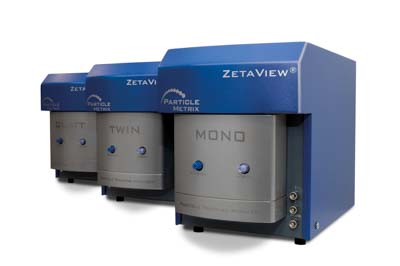+49 (0)8143-99172-0
Headquarter
+49 (0)8143-99172-22
Support


0x consumables
5x faster switching
10x faster cleaning
12x fluorescence channels
∞x statistics
…and much more!

We measure your products in a measuring range of 0.8 nm to 300 μm, if possible in original concentration
The particular area of expertise focuses on investigating the roles of extracellular vesicles (EVs) in cancer and cellular stress responses.
Dr Genevieve Melling is a postdoctoral researcher in the Department of Biological and Medical Sciences at Oxford Brookes University. She works in the laboratory of Dr Dave Carter which has been established to study the effects of non-coding RNAs and extracellular vesicles in stress response. Her particular area of expertise focuses on investigating the roles of extracellular vesicles (EVs) in cancer and cellular stress responses, with particular interests in functional EV effects and EV uptake. EVs are small cargo-carrying vesicles that can be released by cells into the extracellular space. For many years it was thought that EVs were simply a route by which cells removed unwanted material, but it is now realised that they have a range of important functional roles and are part of the molecular dialogue that cells use to communicate. They are investigating how EVs are taken up by cells and how they are able to cause changes to the recipient cells. One of the key parameters measured is that of the EVs’ particle size. For this work, Dr Melling uses the ZetaView® system from Particle Metrix supplied by Analytik.
Dr Melling describes her work: “We currently use the ZetaView® to compare yields from different EV preparation techniques, to assess changes in particle (EVs) concentration between different experimental conditions, and to normalise the concentrations of EVs we use in cell treatments. In the future, we hope to use the fluorescence capability of the ZetaView® to analyse subpopulations of EVs. Having tried other commercial particle characterisation systems, we choose the ZetaView® because we find the automated scanning of multiple positions and video analysis capabilities of the unit convenient for quick analysis of our EV preparations. The software is user friendly, and the machine is easy to set up. We can also dilute our samples allowing for minimal loss of sample size for downstream experiments/ analysis.”
Product specialist, Adam Hilless, says “the ZetaView® has become established in the study of EVs in preference to other techniques because of its ability to make measurements at eleven different positions in the sample cell making it a more robust and representative analysis than single-point analysers. Its fluorescence capability gives specificity to detection meaning that fluorescently-labelled sub-populations of EVs may be detected and measured. Added to the ability to measure zeta potential, this makes the ZetaView® a very powerful characterisation tool in one small and compact box.”
via Analytik Ltd.
Headquarter
Support
Opt-out complete; your visits to this website will not be recorded by the Web Analytics tool. Note that if you clear your cookies, delete the opt-out cookie, or if you change computers or Web browsers, you will need to perform the opt-out procedure again.
You may choose to prevent this website from aggregating and analyzing the actions you take here. Doing so will protect your privacy, but will also prevent the owner from learning from your actions and creating a better experience for you and other users.
The tracking opt-out feature requires cookies to be enabled.